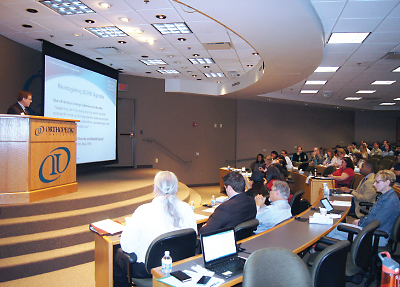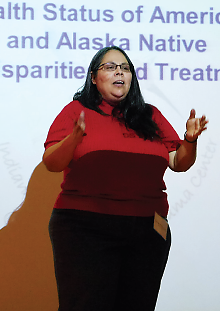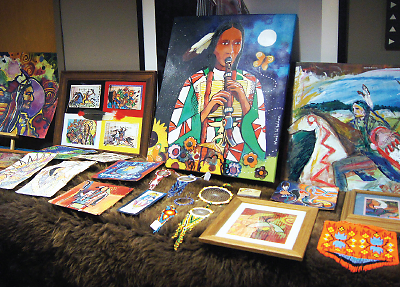APA Event Highlights Mental Health Needs of American Indians
Abstract
Last month, community leaders and mental health professionals met in Sioux Falls, S.D., to call for more to be done to address the mental health needs of American Indians—a community that has long experienced lower health status when compared with other Americans.

APA CEO and Medical Director Saul Levin, M.D., M.P.A., welcomes the audience to the Division of Diversity and Health Equity’s program, “Addressing American Indian Mental Health Disparities,” held in Sioux Falls, S.D., in April.
“We know what the health inequities are among the Native American population,” APA CEO and Medical Director Saul Levin, M.D., M.P.A., told conference attendees. “It’s time for us to do something. APA is here to help and can use its lobbyists to help address these issues.”
The event was sponsored by APA’s Division of Diversity and Health Equity (DDHE) in conjunction with the South Dakota Psychiatric Association as part of the DDHE “On Tour” series. This traveling program aims to increase public awareness of mental health disparities among certain populations. South Dakota was chosen as a target region because American Indians in the state have the lowest “human development” scores—a measure of health based on the combination of income, education, and life expectancy—compared with American Indians from other states.
Debanjana Bhattacharya, M.D., M.P.H., a fourth-year psychiatry resident at the Sanford School of Medicine at the University of South Dakota and APA minority fellow, described the toll mental illness was having on the people of South Dakota alone: “Suicide rates for American Indians in South Dakota are 2.5 times higher than the rates in the surrounding states of Iowa, Nebraska, and North Dakota.” Bhattacharya, who helped organize the event, also noted that alcohol use disorder is another leading cause of death among American Indians residing in South Dakota.
In addition, American Indians in South Dakota have an average life expectancy of 68.2 years—12 years less than the average life expectancy of whites in the state. And while only 9.8 percent of white South Dakotans are living below poverty levels, almost 50 percent of American Indian residents are living under these conditions.
“Many policies, processes, and systems are structured—intentionally or unintentionally—to benefit some populations more than others,” Melanie Peterson-Hickey, Ph.D., the acting director of the Center for Health Equity in the Minnesota Department of Health, told event attendees. “American Indian as well as African American infants have twice the chance of dying in the first year compared with a white infant in Minnesota, yet no one seems to be outraged. … We should be.”

Tawa Witko, Psy.D., a clinical psychologist on the Standing Rock Indian Reservation, discusses the historical factors that have contributed to the proliferation of mental health issues among American Indian communities.
Peterson-Hickey, a member of the Lac du Flambeau Band of Lake Superior Chippewa Indians, explained that achieving equity and eliminating health disparities requires valuing everyone and making intentional, consistent efforts to address systematic inequalities and historical injustices. Conference speaker Tawa Witko, Psy.D., a clinical psychologist for the Indian Health Services at the McLaughlin Health Clinic on the Standing Rock Indian Reservation in South Dakota, agreed.
“Being prohibited by law to openly practice religion until 1978, enrolling Native children into federally funded boarding schools to assimilate them into American culture, as well as urban migration into the city are some of the factors that have contributed to the loss of identity in many American Indian people,” said Witko, who is a part of the Lakota tribe, in an interview. “Being stripped of culture, people will lose their sense of value and self-worth, which can heavily impact mental health.”
As a provider of mental health services to American Indian children and adults, Witko told the audience that it is important in the American Indian community to practice therapy that is culturally competent by incorporating the ceremonial practices of patients as well as extended families into treatment.
To help provide better services to American Indians in the Sioux Falls area, individuals from the public and private sectors recently formed the Alliance for American Indian Behavioral Health. Its aim is to advance health equity for American Indians through the promotion of available resources and training in cultural competence for non-American Indian health care professionals.

Artwork and craftwork depicting the American Indian culture were displayed by the Choteau Creek Trading Post, an American Indian–owned gallery based in Sioux Falls, S.D.
DDHE Director Ranna Parekh, M.D., told Psychiatric News that she was pleased with the overall outcome of the conference. “There were over 125 people in attendance from Sioux Falls and neighboring areas, which implies that there is a great interest in the well-being of American Indians and commitment to end mental health care disparities among this population.”
Levin asked all conference organizers, the DDHE administration, and members of the audience plan to meet again in six months via video conference to continue to discuss next steps for reducing mental health disparities among American Indians. ■



